Intelligent Prediction of Transformer Loss for Low Voltage Recovery in Distribution Network with Unbalanced Load
Abstract
:1. Introduction
2. Distribution Network Data Processing
3. Calculation of Zero-Sequence Impedance of Transformer Modeling of Transformers under Unbalanced Loads
4. Calculation of Zero-Sequence Impedance of Transformer
- Let the maximum number of iteration be 100, and the initial number of qualified points be 25. For each candidate solution Xi, it is composed of some decision variables xi,j, it represents the position of these qualified seeds in the Sierpinski triangle. The Sierpinski triangle needs to be used as the search space for the candidate solution. The mathematical model is shown in (25).where n is the number of qualified seeds in the search space, and d is the dimension of these seeds.
- The initial position of qualified seeds is determined by (26) and the corresponding fitness is calculated. For these seeds, the initial position is determined randomly in the search space, and the expression is shown in (26).where is the initial position of qualified seeds, and are the maximum and minimum values of the jth decision variable in the ith candidate solutions and the rand function is a random number within the interval [0, 1].
- The global optimal eligibility point and global optimal value GB are determined.
- For each eligible point Xi in the search space, the average value MGi is determined.
- For each eligible point Xi in the search space, a temporary triangle is determined by using Xi, MGi and GB.
- For each temporary triangle, the position of four seeds is updated. In this algorithm, four methods for creating seeds are proposed to achieve optimization objectives. The first seed is located in Xi, the second seed is located in GB, the third seed is located in MGi and the position of the fourth seed is generated based on a random candidate solution. The expression is shown in (27).where αi can be determined by using (28).where the Rand function is a random vector within [0, 1], δ and ε are a random vector within [0, 1].
- The location of the seed is evaluated, and the fitness value is updated.
- Determine whether current iteration number has exceeded the maximum iteration number. If the maximum number of iterations has not been exceeded, return to step (3) to iterate and calculate. If the maximum number of iterations has been exceeded, the optimal location and global optimal solution will be output.
5. Modeling of Transformer Loss Based on PCA-SSA-BP
- The original power data set detected in distribution network is {UA, UB, UC, IA, IB, IC, θA, θB, θC, In};
- The input dimension of the transformer loss prediction model is reduced by using Principal Component Analysis, expressed as {Y1, Y2, Y3, Y4, Y5, Y6, Y7, Y8};
- The 2016 groups of data detected in the distribution network are divided into two groups. The 1616 groups of data are used to train the transformer loss prediction model, and the 400 groups of data are used to test the established transformer loss prediction model;
- The initial size of sparrow population n is defined as n = 30, and the maximum number of iteration N is defined as N = 100.
- The topological structure of BP network and the search space dimension dim of sparrow search algorithm are determined, the input layer and hidden layer are defined as M and N, respectively, then the structure is M − N − 1, and the search dimension dim is M × N + N × 1 + N + 1;
- Then, the fitness function is determined. In this paper, the fitness function is defined as the average value of the mean square error of the training set and the mean square error of the test set. The function is shown in (30).where N1 is the number of training sets, N1 = 1616, N2 is the number of test sets, N2 = 400, N = N1 + N2; ytrain is the output value of training set, ytest is the output value of test set and y is the actual value.
- The fitness values of the initial sparrow population are calculated and ranked, and the current corresponding best value fbest and the worst value fworst are selected.
- The location of the discoverer, the joiner and the sparrow individuals who sense danger are updated according to steps (6) and (7).
- According to the iteration rules, if the current optimal value is better than the last iteration result, the update will continue, otherwise it will not be updated, and the iteration will continue.
- Set iteration termination criteria. When the fitness value is less than the accuracy of the initial model or the number of iterations is exhausted, the iteration will be terminated, and the optimal fitness value and its corresponding global optimal position bestx will be output.
- The BP network is optimized by using the global optimal position bestx, the optimal weight and threshold parameters are obtained and assigned to the BP network model, so as to realize training and simulation prediction of the network.
6. Example Verification
6.1. Verification of Zero-Sequence Impedance
6.2. Verification of Neutral Line Current
6.3. Verification of Transformer Voltage
6.4. Intelligent Prediction of Transformer Loss Based on PCA-SSA-BP
7. Conclusions
Author Contributions
Funding
Data Availability Statement
Conflicts of Interest
References
- Xie, F.; Yin, Z.; Luo, A.; Yuan, J. Prediction of Distribution Network Line Loss Based on Grey Relation Analysis and XGboost. In Proceedings of the 2021 IEEE 2nd International Conference on Big Data, Artificial Intelligence and Internet of Things Engineering (ICBAIE), Nanchang, China, 26–28 March 2021; pp. 279–284. [Google Scholar]
- Li, G.; Li, J.; Li, L.; Yu, S.; Wang, N.; Pan, S.; Ding, H.; Su, Z. Research on the Influence of Distributed Photovoltaics on Distribution Network Voltage in Three-phase Unbalanced State. In Proceedings of the 2022 4th International Conference on Power and Energy Technology (ICPET), Beijing, China, 28–31 July 2022; pp. 715–720. [Google Scholar]
- Wang, W.; Wang, W.; Song, S.; Hu, W.; Guo, Q. Study on Daily Line Loss Calculation Based on Operation Data and Resistance Characteristics of Low Voltage Distribution Transformer Area. In Proceedings of the 2021 International Conference on Power System Technology (POWERCON), Haikou, China, 8–9 December 2021; pp. 2093–2096. [Google Scholar]
- Mikic, O.M. Variance-Based Energy Loss Computation in Low Voltage Distribution Networks. IEEE Trans. Power Syst. 2007, 22, 179–187. [Google Scholar] [CrossRef]
- Fan, Y.; Jun, L.; Bingbing, L. Design and application of integrated distribution network line loss analysis system. In Proceedings of the 2016 China International Conference on Electricity Distribution (CICED), Xi’an, China, 10–13 August 2016; pp. 1–4. [Google Scholar]
- Chen, B.; Xiang, K.; Yang, L.; Su, Q.; Huang, D.; Huang, T. Theoretical Line Loss Calculation of Distribution Network Based on the Integrated Electricity and Line Loss Management System. In Proceedings of the 2018 China International Conference on Electricity Distribution (CICED), Tianjin, China, 17–19 September 2018; pp. 2531–2535. [Google Scholar]
- Guihong, F.; Jianbin, Z.; Shuqiu, G.; Bingyi, Z. Line Losses Analysis and Management System of Distribution Networks Based on Local Area Network. In Proceedings of the 2005 IEEE/PES Transmission & Distribution Conference & Exposition: Asia and Pacific, Dalian, China, 18 August 2005; pp. 1–4. [Google Scholar]
- Feng, N.; Jianming, Y. Line losses calculation in distribution network based on RBF neural network optimized by hierarchical GA. In Proceedings of the 2009 International Conference on Sustainable Power Generation and Supply, Nanjing, China, 6–7 April 2009; pp. 1–5. [Google Scholar]
- Wang, W.; Wang, J.; Song, S.; Hu, W.; Guo, Q. Distribution Network Monthly Line Loss Calculate and Improvement with Convolutional Neural Network. In Proceedings of the 2021 China International Conference on Electricity Distribution (CICED), Shanghai, China, 7–9 April 2021; pp. 1035–1039. [Google Scholar]
- Huang, W.; Chen, J.; Liu, C.; Shi, W.; Lin, C.; Lyu, X.; Gao, H. Research on Line-Loss Correlation Analysis Technology of Distribution Network Based on Apriori Algorithm. In Proceedings of the 2020 5th Asia Conference on Power and Electrical Engineering (ACPEE), Chengdu, China, 4–7 June 2020; pp. 1399–1403. [Google Scholar]
- Xu, Y. Optimization of BP artificial neural network regression prediction model based on Improved Sparrow search algorithm with Sine chaotic mapping and its application. In Proceedings of the 2021 IEEE International Conference on Emergency Science and Information Technology (ICESIT), Chongqing, China, 22–24 November 2021; pp. 231–234. [Google Scholar]
- Yin, L.; Chen, A.; Wu, M. The Application of Grey Relational Analysis Model in the Detection of Communication Interrupt in Self-Organizing Network. In Proceedings of the 2014 Fourth International Conference on Instrumentation and Measurement, Computer, Communication and Control, Harbin, China, 18–20 September 2014; pp. 435–438. [Google Scholar]
- Chen, J.; Dong, Q.; Ni, X.; Hu, M. Quantitative Analysis of Heavy Metal Components in Soil by Laser-Induced Breakdown Spectroscopy Based on Principal Component Analysis. In Proceedings of the 2019 18th International Conference on Optical Communications and Networks (ICOCN), Huangshan, China, 5–8 August 2019; pp. 1–4. [Google Scholar]
- Allcock, R.; Haydock, L.; Holland, S. Calculation of zero phase sequence impedance for power transformers using numerical methods. IEEE Trans. Magn. 1995, 31, 2048–2051. [Google Scholar] [CrossRef]
- Ramadan, A.; Kamel, S.; Hussein, M.M.; Hassan, M.H. A New Application of Chaos Game Optimization Algorithm for Parameters Extraction of Three Diode Photovoltaic Model. IEEE Access 2021, 9, 51582–51594. [Google Scholar] [CrossRef]
- An, Y.; Fan, R.; Liu, B.; Deng, C.; Cai, M.; Lin, S. A method for calculating the zero sequence impedance of distribution transformers. Transformer 2018, 55, 1–4. [Google Scholar] [CrossRef]


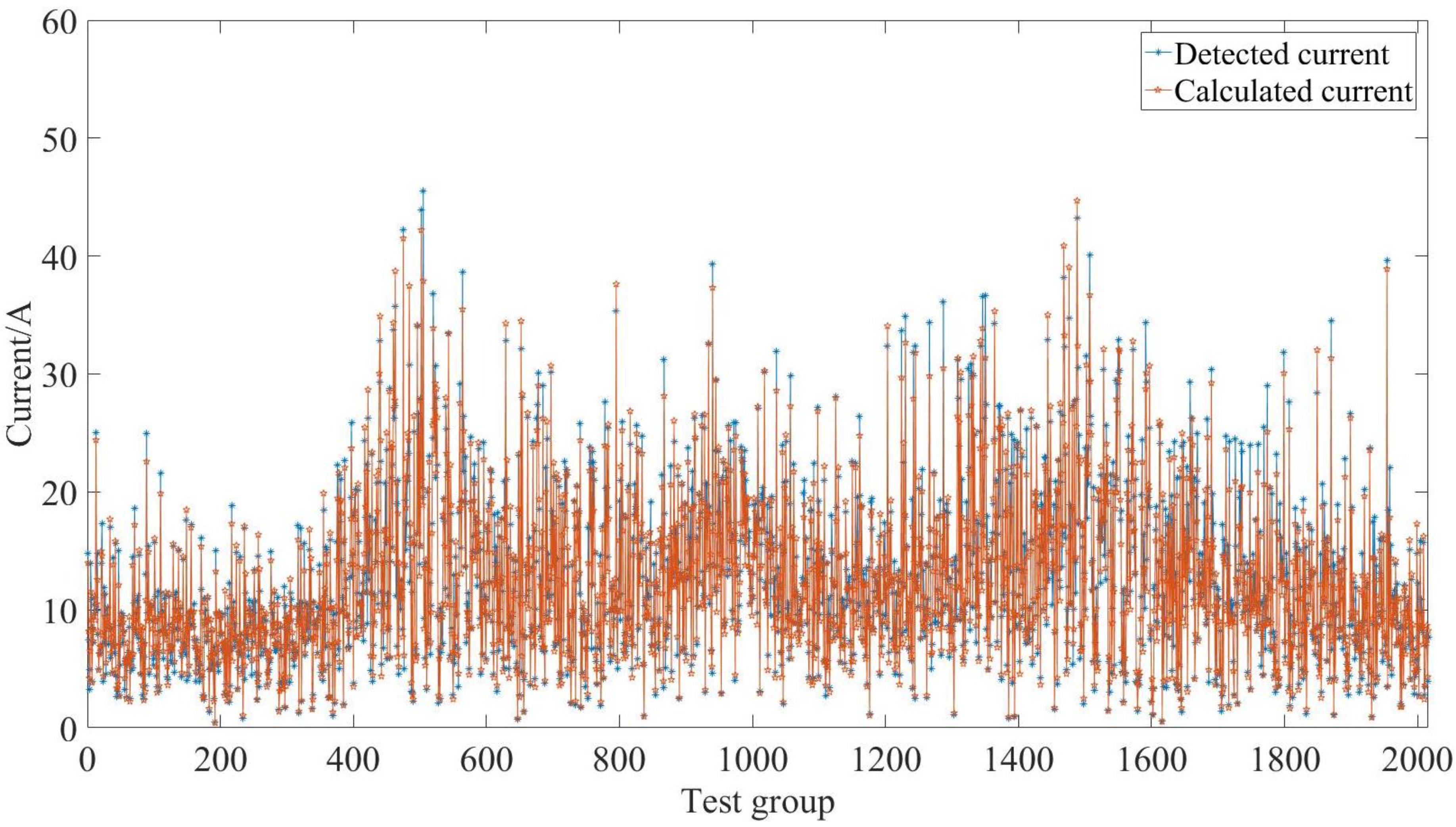

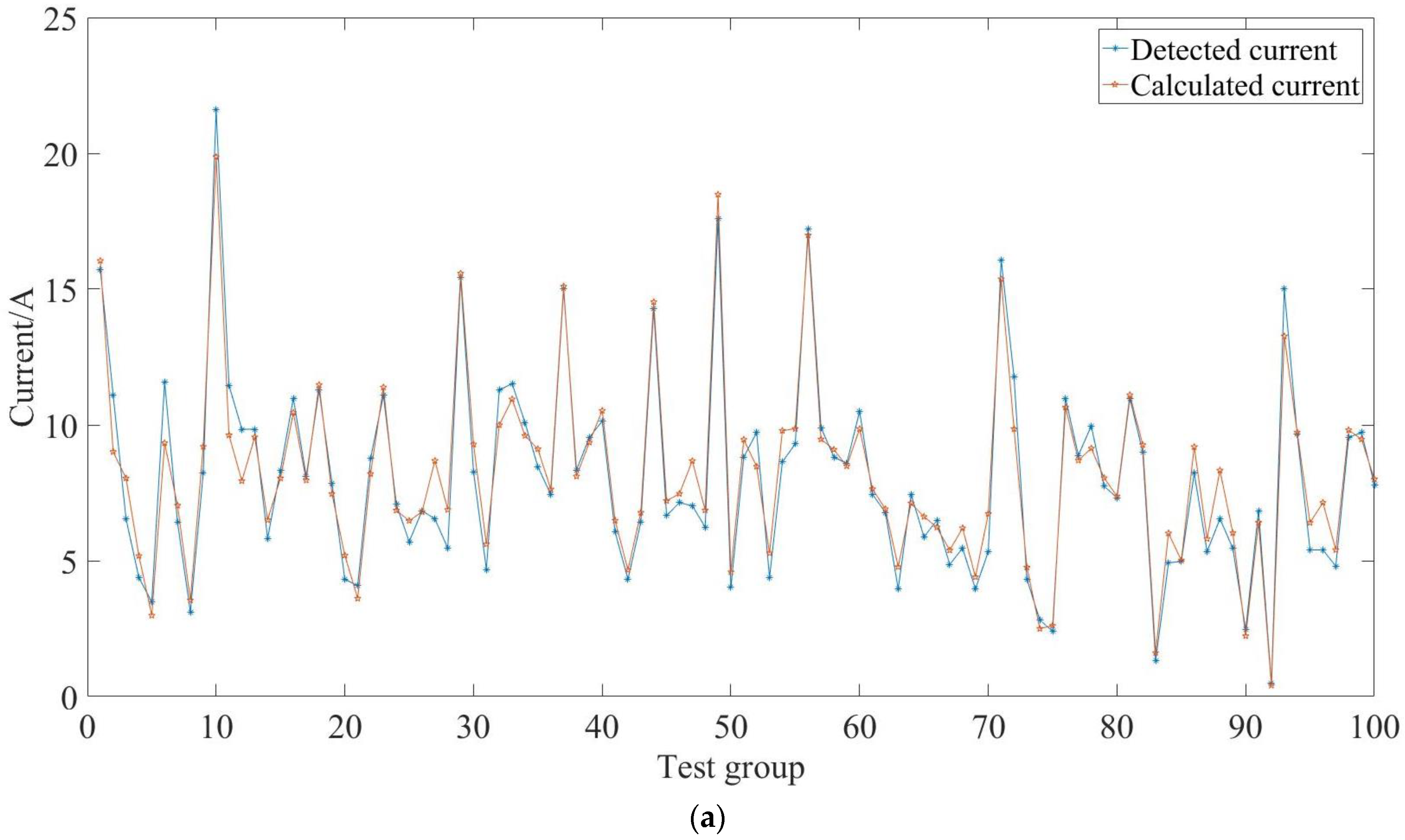


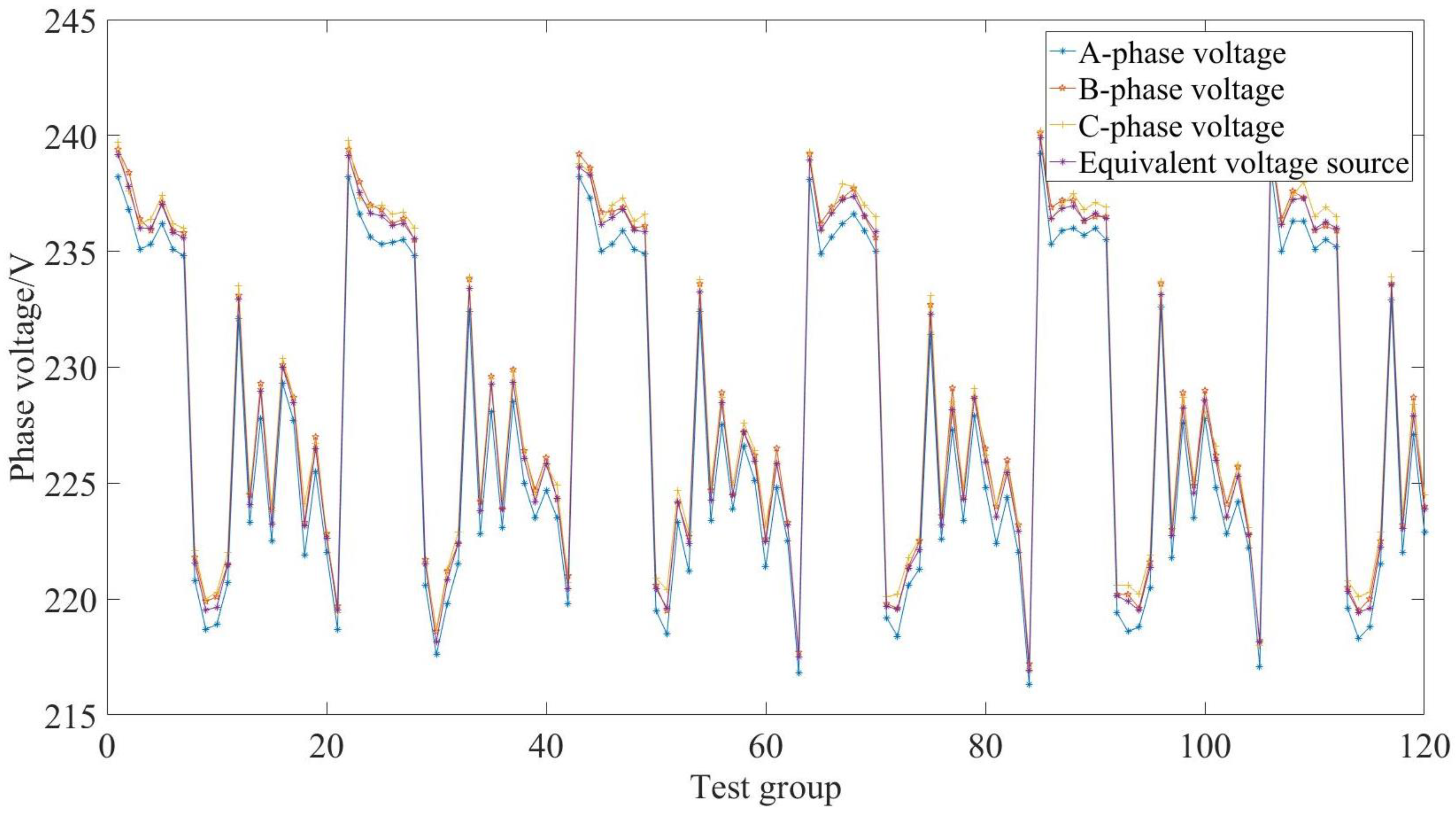
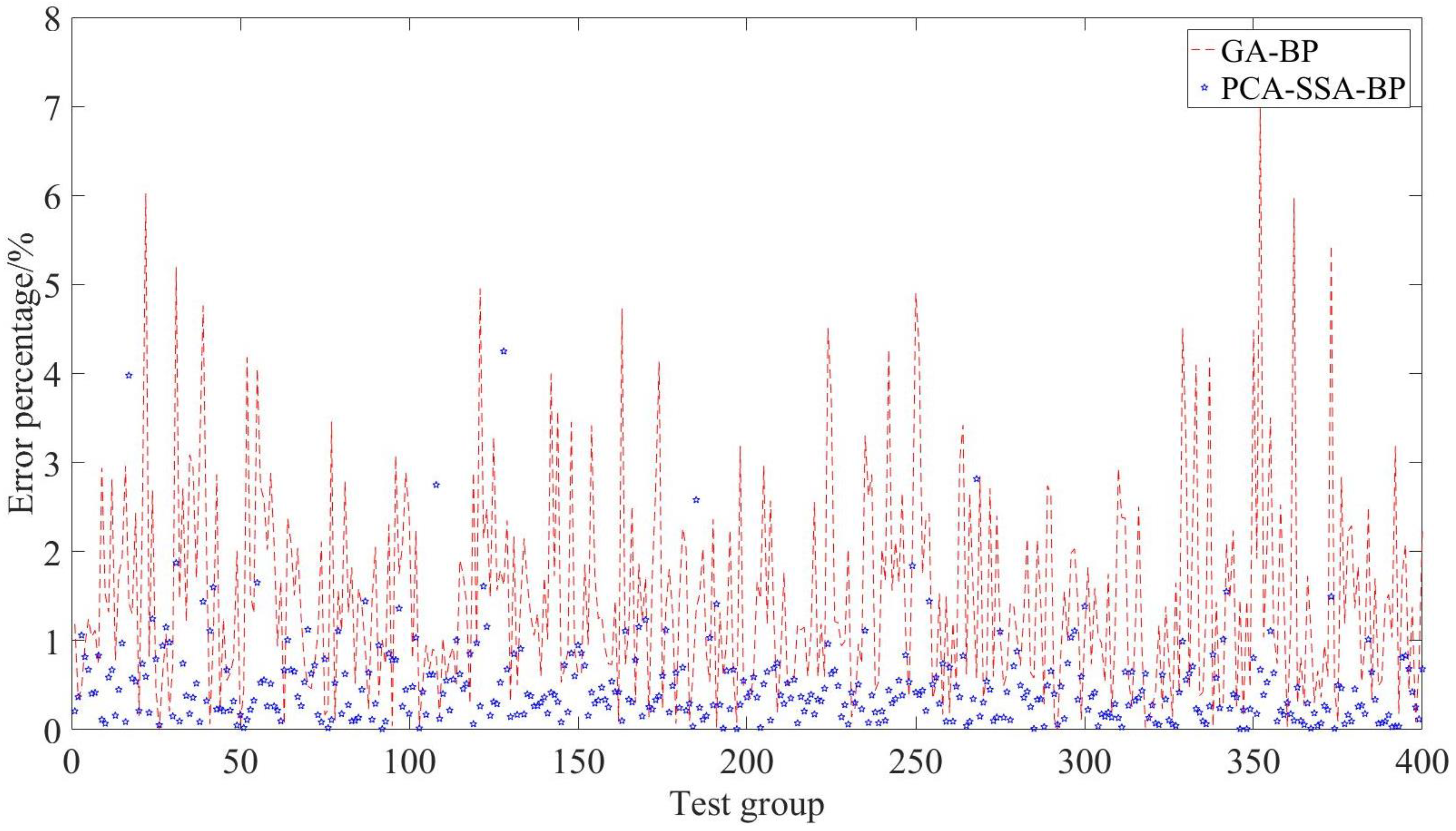
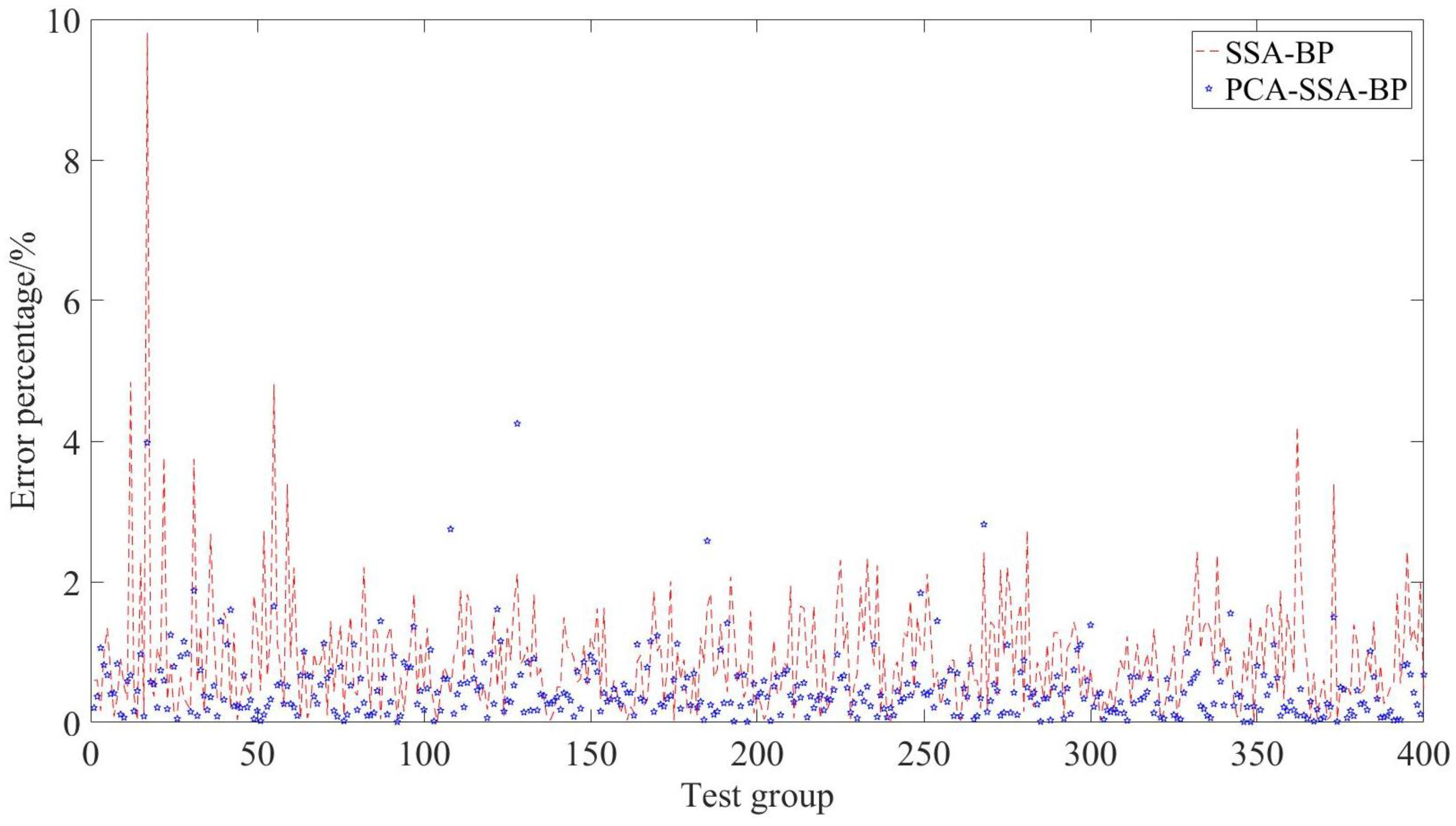
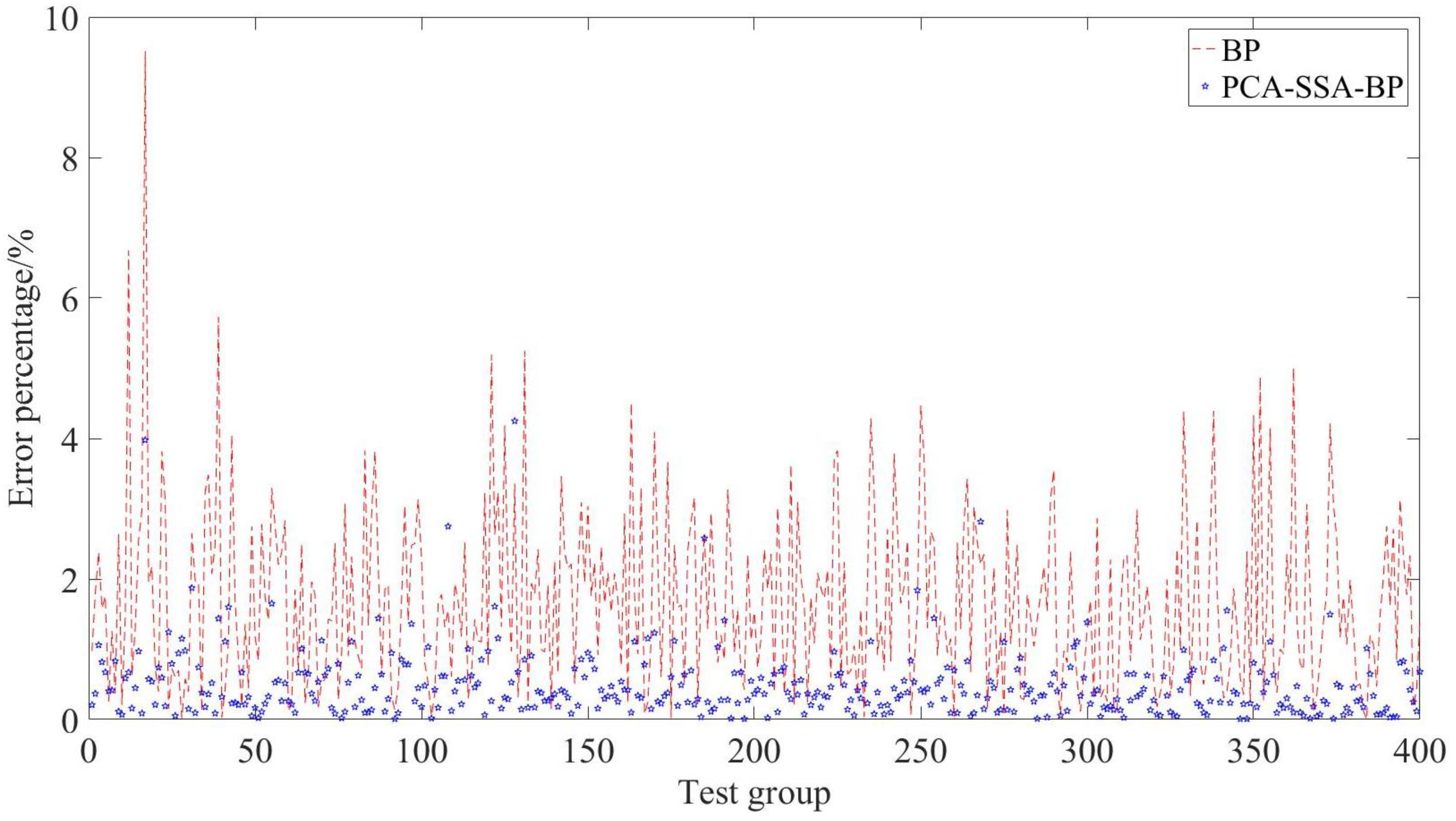

| Correlation Result | ||
|---|---|---|
| Evaluation Items | Relevancy | Rank |
| UA | 0.942 | 1 |
| UC | 0.942 | 2 |
| UB | 0.942 | 3 |
| θA | 0.900 | 4 |
| θC | 0.894 | 5 |
| IC | 0.888 | 6 |
| In | 0.887 | 7 |
| θB | 0.886 | 8 |
| IA | 0.886 | 9 |
| IB | 0.886 | 10 |
| Number | UA/V | UB/V | UC/V | IA/A | IB/A | IC/A | θA/° | θB/° | θC/° | In/A |
|---|---|---|---|---|---|---|---|---|---|---|
| 1 | 242.40 | 238.50 | 236.20 | 1.24 | 1.28 | 4.86 | −7.65 | −15.68 | 18.08 | 3.68 |
| 2 | 247.30 | 232.80 | 229.50 | 4.24 | 4.36 | 14.20 | −7.84 | −8.38 | 4.04 | 9.91 |
| 3 | 242.20 | 231.50 | 231.70 | 2.94 | 3.86 | 11.14 | 10.18 | −5.30 | 2.85 | 6.91 |
| 4 | 238.80 | 233.40 | 232.80 | 0.92 | 1.86 | 5.24 | −13.76 | −6.63 | 15.78 | 3.75 |
| 5 | 247.90 | 232.40 | 227.40 | 1.30 | 1.10 | 12.76 | −9.34 | −20.22 | 7.12 | 11.56 |
| 6 | 234.00 | 239.00 | 232.20 | 5.74 | 0.96 | 3.78 | 7.04 | −23.12 | 12.53 | 4.77 |
| 7 | 238.40 | 235.00 | 232.00 | 1.26 | 1.02 | 5.76 | 36.71 | −27.41 | 21.83 | 3.94 |
| Number | UA′ | UB′ | UC′ | IA′ | IB′ | IC′ | θA′ | θB′ | θC′ | In′ |
|---|---|---|---|---|---|---|---|---|---|---|
| 1 | 0.49 | 0.84 | 0.79 | −0.78 | −0.44 | −0.61 | −1.56 | −1.26 | −0.08 | −0.46 |
| 2 | 1.00 | 0.13 | 0.06 | 0.37 | 0.69 | 0.76 | −1.57 | −0.78 | −1.35 | 0.57 |
| 3 | 0.47 | −0.03 | 0.30 | −0.13 | 0.50 | 0.31 | −0.83 | −0.58 | −1.45 | 0.07 |
| 4 | 0.11 | 0.21 | 0.42 | −0.90 | −0.23 | −0.55 | −1.81 | −0.67 | −0.28 | −0.44 |
| 5 | 1.06 | 0.08 | −0.17 | −0.76 | −0.51 | 0.55 | −1.63 | −1.55 | −1.07 | 0.84 |
| 6 | −0.39 | 0.90 | 0.36 | 0.95 | −0.56 | −0.77 | −0.96 | −1.74 | −0.58 | −0.28 |
| 7 | 0.07 | 0.41 | 0.34 | −0.77 | −0.54 | −0.48 | 0.27 | −2.02 | 0.26 | −0.41 |
| Factor | UA | UB | UC | IA | IB | IC | θA | θB | θC | In |
|---|---|---|---|---|---|---|---|---|---|---|
| UA | 1.00 | 0.45 | 0.25 | −0.20 | −0.01 | 0.55 | −0.24 | −0.02 | −0.39 | 0.57 |
| UB | 0.45 | 1.00 | 0.75 | 0.08 | −0.33 | −0.34 | −0.10 | 0.14 | 0.27 | −0.22 |
| s | 0.25 | 0.75 | 1.00 | −0.25 | 0.09 | −0.57 | 0.02 | 0.19 | 0.29 | −0.51 |
| IA | −0.20 | 0.08 | −0.25 | 1.00 | 0.14 | 0.19 | −0.14 | 0.04 | −0.14 | 0.25 |
| IB | −0.01 | −0.33 | 0.09 | 0.14 | 1.00 | 0.25 | −0.22 | −0.02 | −0.21 | 0.21 |
| IC | 0.55 | −0.34 | −0.57 | 0.19 | 0.25 | 1.00 | −0.19 | −0.14 | −0.61 | 0.94 |
| θA | −0.24 | −0.10 | 0.02 | −0.14 | −0.22 | −0.19 | 1.00 | 0.50 | 0.39 | −0.29 |
| θB | −0.02 | 0.14 | 0.19 | 0.04 | −0.02 | −0.14 | 0.50 | 1.00 | 0.33 | −0.16 |
| θC | −0.39 | 0.27 | 0.29 | −0.14 | −0.21 | −0.61 | 0.39 | 0.33 | 1.00 | −0.57 |
| In | 0.57 | −0.22 | −0.51 | 0.25 | 0.21 | 0.94 | −0.29 | −0.16 | −0.57 | 1.00 |
| Initial Characteristic Value | |||
|---|---|---|---|
| Component | Total | Percentage of Variance | Accumulate/% |
| 1 | 3.506 | 35.062 | 35.062 |
| 2 | 2.002 | 20.023 | 55.085 |
| 3 | 1.362 | 13.622 | 68.707 |
| 4 | 1.134 | 11.345 | 80.052 |
| 5 | 1.055 | 10.545 | 90.597 |
| 6 | 0.472 | 4.724 | 95.321 |
| 7 | 0.388 | 3.883 | 99.204 |
| 8 | 0.056 | 0.563 | 99.767 |
| 9 | 0.015 | 0.147 | 99.915 |
| 10 | 0.009 | 0.085 | 100 |
| Component | 1 | 2 | 3 | 4 | 5 | 6 | 7 | 8 |
|---|---|---|---|---|---|---|---|---|
| UA | 0.42 | 0.83 | 0.31 | −0.16 | 0.09 | 0.03 | 0.03 | −0.08 |
| UB | −0.44 | 0.81 | 0.04 | 0.18 | −0.32 | 0.03 | 0.08 | 0.01 |
| UC | −0.62 | 0.67 | −0.12 | 0.19 | 0.29 | −0.11 | 0.10 | 0.05 |
| IA | 0.25 | −0.15 | −0.02 | 0.77 | −0.55 | −0.09 | 0.11 | −0.03 |
| IB | 0.32 | −0.07 | −0.21 | 0.56 | 0.72 | 0.09 | 0.12 | −0.01 |
| IC | 0.92 | 0.06 | 0.33 | −0.02 | 0.03 | 0.11 | 0.08 | −0.10 |
| θA | −0.44 | −0.36 | 0.67 | −0.11 | 0.09 | −0.19 | 0.41 | 0.01 |
| θB | −0.37 | −0.04 | 0.74 | 0.35 | 0.16 | −0.07 | −0.40 | 0.00 |
| θC | −0.77 | −0.15 | 0.13 | 0.06 | −0.06 | 0.59 | 0.07 | −0.02 |
| In | 0.90 | 0.16 | 0.29 | 0.04 | −0.07 | 0.19 | 0.04 | 0.19 |
| Component | UA | UB | UC | IA | IB | IC | θA | θB | θC | In |
|---|---|---|---|---|---|---|---|---|---|---|
| U1 | 0.22 | −0.23 | −0.33 | 0.14 | 0.17 | 0.49 | −0.24 | −0.20 | −0.41 | 0.48 |
| U2 | 0.59 | 0.57 | 0.47 | −0.11 | −0.05 | 0.04 | −0.25 | −0.03 | −0.11 | 0.11 |
| U3 | 0.26 | 0.04 | −0.10 | −0.02 | −0.18 | 0.28 | 0.57 | 0.63 | 0.11 | 0.24 |
| U4 | −0.15 | 0.17 | 0.18 | 0.72 | 0.52 | −0.02 | −0.10 | 0.33 | 0.06 | 0.03 |
| U5 | 0.09 | −0.32 | 0.29 | −0.53 | 0.70 | 0.03 | 0.09 | 0.15 | −0.06 | −0.07 |
| U6 | 0.05 | 0.04 | −0.17 | −0.13 | 0.13 | 0.16 | −0.28 | −0.09 | 0.87 | 0.27 |
| U7 | 0.05 | 0.12 | 0.17 | 0.18 | 0.19 | 0.12 | 0.66 | −0.64 | 0.12 | 0.07 |
| U8 | −0.35 | 0.03 | 0.23 | −0.13 | −0.06 | −0.43 | 0.05 | 0.02 | −0.09 | 0.78 |
| Variable | Constraint Range |
|---|---|
| E | [150, 400] |
| Rn | [0, 10] |
| Xn | [0, 10] |
| αA | [−60, 60] |
| αB | [−180, −60] |
| αC | [60, 180] |
| Type | Connection Layout | Capacity/kVA | Short Circuit Impedance/% | Rated Voltage/kV | Short Circuit Loss/W |
|---|---|---|---|---|---|
| S11 | Yyn0 | 315 | 4 | 10/0.4 | 3830 |
| Paper Data/Ω | Measured Data/Ω | Calculated Data/Ω | Error Percentage |
|---|---|---|---|
| 0.094 | 0.087 | 0.094 | 8.44% |
| 0.108 | 0.110 | 0.110 | 0.17% |
| 0.112 | 0.112 | 0.113 | 0.90% |
| 0.089 | 0.094 | 0.094 | 0.42% |
| 0.103 | 0.109 | 0.106 | 2.57% |
| A Phase Voltage/V | B Phase Voltage/V | C Phase Voltage/V | Three-Phase Voltage Source Value/V |
|---|---|---|---|
| 243.10 | 233.60 | 237.50 | 238.87 |
| 240.40 | 234.00 | 228.70 | 235.27 |
| 242.70 | 237.20 | 231.40 | 237.88 |
| 237.10 | 232.50 | 230.50 | 234.46 |
| 238.70 | 233.40 | 233.40 | 235.96 |
| Paper Data/A | Calculation Data/A | Error Percentage |
|---|---|---|
| 52.76 | 52.76 | 0.008% |
| 60.46 | 60.39 | 0.111% |
| 55.90 | 55.87 | 0.046% |
| 42.00 | 42.10 | 0.248% |
| 32.30 | 32.33 | 0.095% |
| Type | Connection Layout | Capacity/kVA | Short Circuit Impedance/% | Rated Voltage/kV | Short Circuit Loss/W |
|---|---|---|---|---|---|
| S13 | Dyn11 | 50 | 4 | 10/0.4 | 870 |
| Value | GA-BP | SSA-BP | BP | PSO-BP | PCA-SSA-BP |
|---|---|---|---|---|---|
| Minimum value | 0.004% | 0.003% | 0.005% | 0.001% | 0.002% |
| Maximum value | 7.035% | 9.806% | 9.515% | 9.920% | 4.250% |
| Median value | 1.228% | 0.765% | 1.532% | 1.005% | 0.364% |
| Average value | 1.64% | 0.94% | 1.75% | 1.45% | 0.63% |
Disclaimer/Publisher’s Note: The statements, opinions and data contained in all publications are solely those of the individual author(s) and contributor(s) and not of MDPI and/or the editor(s). MDPI and/or the editor(s) disclaim responsibility for any injury to people or property resulting from any ideas, methods, instructions or products referred to in the content. |
© 2023 by the authors. Licensee MDPI, Basel, Switzerland. This article is an open access article distributed under the terms and conditions of the Creative Commons Attribution (CC BY) license (https://creativecommons.org/licenses/by/4.0/).
Share and Cite
Dai, Z.; Shi, K.; Zhu, Y.; Zhang, X.; Luo, Y. Intelligent Prediction of Transformer Loss for Low Voltage Recovery in Distribution Network with Unbalanced Load. Energies 2023, 16, 4432. https://doi.org/10.3390/en16114432
Dai Z, Shi K, Zhu Y, Zhang X, Luo Y. Intelligent Prediction of Transformer Loss for Low Voltage Recovery in Distribution Network with Unbalanced Load. Energies. 2023; 16(11):4432. https://doi.org/10.3390/en16114432
Chicago/Turabian StyleDai, Zikuo, Kejian Shi, Yidong Zhu, Xinyu Zhang, and Yanhong Luo. 2023. "Intelligent Prediction of Transformer Loss for Low Voltage Recovery in Distribution Network with Unbalanced Load" Energies 16, no. 11: 4432. https://doi.org/10.3390/en16114432
APA StyleDai, Z., Shi, K., Zhu, Y., Zhang, X., & Luo, Y. (2023). Intelligent Prediction of Transformer Loss for Low Voltage Recovery in Distribution Network with Unbalanced Load. Energies, 16(11), 4432. https://doi.org/10.3390/en16114432






